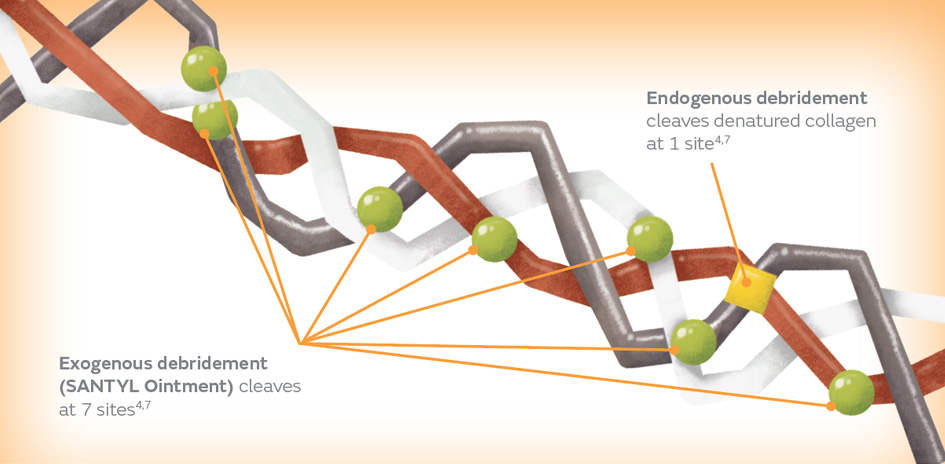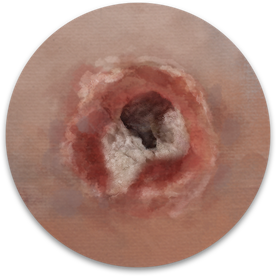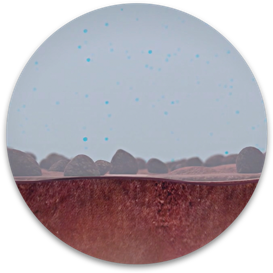It’s time to think differently about SANTYL◊ Ointment
SANTYL Ointment is the only enzymatic method of debridement shown to uniquely help move wounds toward closure.8-11
The only FDA-approved biologic debridement agent for both chronic dermal ulcers and severely burned areas, SANTYL Ointment takes enzymatic debridement to the next level through its active ingredient collagenase. Clostridial Collagenase is an exogenous bacterial enzyme that works in a selective, ongoing manner to cleave necrotic tissue at seven sites along the denatured collagen strand.4,7
These collagen byproducts created by debridement with SANTYL Ointment really make the difference by stimulating the migration and proliferation of fibroblasts, keratinocytes, and endothelial cells.8-11 Here’s how:
- SANTYL Ointment debrides by cleaving necrotic tissue at 7 specific sites along the denatured collagen strand – unlike endogenous methods that only cleave at a single site4,7
- This unique 7-site collagen cleavage process creates bioactive peptide byproducts8-11
- These collagen byproducts induce a cellular response that stimulates fibroblast, keratinocyte and endothelial cell migration to the wound bed and are associated with the proliferative phase of wound healing8-11
SANTYL Ointment features a unique mechanism of action that helps move wounds toward closure.
SANTYL Ointment debrides by cleaving necrotic tissue at 7 specific sites along the denatured collagen strand, a process that creates bioactive peptide byproducts. These collagen byproducts induce a cellular response associated with the proliferative phase of healing.8-11
SANTYL Ointment uniquely cleaves at multiple sites on the denatured collagen strand4,7

Endogenous (internal) debridement at 1 site4,7
- Autolytic support
- Endogenous enzymes found naturally in the body, dependent on a person’s immune system
- Autolytic process takes time and is traditionally slow
- Anaerobic (bacterial) growth may occur
- Cleaves necrotic tissue at one specific site along collagen strand
- There are no active ingredients in any autolytic support agent that actively debrides wounds
Exogenous (SANTYL Ointment) debridement at 7 sites4,7
- Exogenous bacterial enzyme
- Works faster and more powerfully than autolytic support
- Active debridement cleaves necrotic tissue at 7 specific sites along the denatured collagen strand
- Breaks and unwinds denatured collagen
SANTYL Ointment debrides on the wound surface and within the wound bed4,7

Macroscopic (on the wound surface)
- Preserves healthy granulation tissue
- Selectively and actively debrides necrotic tissue

Microscopic (within the wound bed)
- Permeates the wound surface between pockets of dead tissue
- Cleaves necrotic tissue along the length of the collagen fiber
- Specifically breaks down all denatured collagen
What is exogenous bacterial collagenase?
The enzyme in SANTYL Ointment is derived from fermentation by Clostridium histolyticum. This type of collagenase works differently than the natural collagenase found in the human body. Unlike human collagenase that splits collagen in its native triple-helical conformation, exogenous bacterial collagenase possesses the unique ability to cleave at multiple sites within triple-helical regions and breaks down denatured collagen in necrotic tissue.4,7

